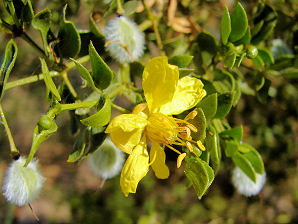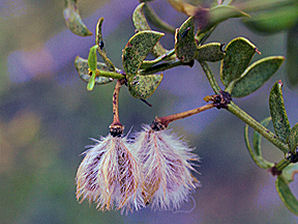Arizona Wild Flowers
Pictures, Photos, Images
Descriptions, Information, Reviews.
Creosote Bush, Larrea tridentata.
We Are Proud Of Our SafeSurf Rating!
Click On Any Of The Following Links By Amazon.Com
For Books, & Videos About Wildflowers Of Arizona & The Southwest USA. No Obligation!
 |
| Creosote Bush, Larrea tridentata |
|---|
 |  |
| Creosote Bush Called Creosote Bush Due To Smell | Not Nector Source For Bees Gives Desert A Creosote Smell After A Rain! |
|---|---|
 |  |
| Creosote Bush Flower Called Creosote Bush Due To Smell | Not Nector Source For Bees Gives Desert A Creosote Smell After A Rain! |
 /
/

Creosote Bush.
We wish to thank Wikipedia, the free encyclopedia for some of the information on this page. We share images and information with Wikipedia. Larrea tridentata is a prominent species in the Mojave, Sonoran, and Chihuahuan Deserts of western North America, and its range includes those and other regions in portions of California, Arizona, Nevada, Utah, New Mexico and western Texas in the United States, and northern Chihuahua and Sonora in Mexico. The species grows as far east as Zapata County, Texas, along the Rio Grande River southeast of Laredo near the 99th meridian west. Creosote Bush is one of the most common shrubs in the Sonoran, Chihuahuan, and Mojave Deserts. It smells like creosote after a rain. Often grows in groups of 3 or more plants. Spaced about 3 ' apart. The leaves contain many anti-herbivory resinous compounds, so the plant is seldom eaten by grazing animals of any kind. Burrowing animals (kangaroo rats and other rodents) dig holes and burrows in the soil round the base of these plants. They seak shelter in these underground burrows during the heat of the day and then emerge to forage at night. Snakes, spiders, and scorpions are sometimes found in these holes. While bees use its pollen, it is not a good source for nectar. This is from our experience of over 45 years as beekeepers. Yet, many noted "authorities" say that it is foraged by bees. Creosote lives a long time. Some plants are thought to be over 11,000 years old!
Quick Notes:
Height: Up To About 3' - 6' Tall, 3 '- 6' wide. Known to reach over 9 feet tall.
Flowers: The color is a bright yellow with five sepals (not petals), 1 inch across, long filaments, yellow anthers, appear in small clusters in early spring with the leaves.
Flowering Time: Mid February - March then again after summer rains in July - September.
Seeds: The seeds are almost circular, 1/2 inch or slightly more in diameter, brown to reddish brown, flattened, irregularly angled, with a finely pitted surface.
Leaves: Small, compound, evergreen, dark green to yellowish - green, consisting of two leaflets, joined at the base. They have a thick, shiny cuticle which withstands water loss.
Found: Native to the Mojave, Sonoran, and Chihuahuan Deserts of western North America. The USDA claims that Larrea tridentata is native of the USA (AZ, CA, NM, NV, TX, UT). In Arizona it is native to all counties except Navajo, Apache, & Gila. In Mexico it is native to the states of Baja Norte, Baja Sur, Chihuahua, Coahuila, Durango, Nuevo Leon, San Luis Potosi, Sonora, Tamaulipas, Zacatecas, Aguascalientes, Hidalgo, & Queretaro.
Hardiness:
Soil pH requirements:
Sun Exposure:
Elevation: 0 - 4,900 Feet.
Habitat: On cultivated, waste and fallow land, roadsides, yards, and other disturbed areas. Dry flats and slopes. In cities and towns also.
Miscellaneous: Flowering Photos Taken March 20, 2003. Glendale, Arizona.
|



We Are Proud Of Our SafeSurf Rating!
Click On Any Of The Following Links By Amazon.Com
For Books, & Videos About Xerioscape Plants Of Arizona & The Southwest USA. No Obligation!
Back To Arizona Wild Flowers Home Page.
Back To Arizona Wild Flowers; Yellow Flowers Page Five.
Back To Arizona Xeriscape Landscaping Main Page.
Back To Xeriscape Shrubs Page One.
Back To DeLange Home Page
© 1966 - Present, Audrey, Eve, & George DeLange
| © 1966 - Present, Audrey, Eve, & George DeLange |


